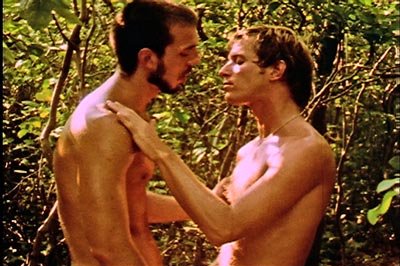Revisiting ‘Boys,’ four decades later
By Ray Simon PGN Contributor
Winter weather may have Philadelphia firmly in its icy grip, but film fans can momentarily turn up the heat by catching Wakefield Poole’s groundbreaking 1971 gay-porn movie “Boys in the Sand,” which plays at International House Feb. 1.
The screening opens with gay director Tom Chomont’s experimental short film “Love Objects” and is part of the series “Free to Love: The Cinema of the Sexual Revolution.”
“Boys in the Sand” mixes poetic imagery and hardcore pornography. Unlike earlier loops, where the sex was often gritty and shameful, “Boys” welcomes viewers to a fantasy world where the frank depiction of gay male sexuality is portrayed as carefree and natural. In each of the film’s three scenes, director Poole, who shot the film himself using a hand-held camera, allows his performers ample time to enjoy one another. He also added touches of humor and tension, two elements generally lacking in most pornography.
According to Jesse Pires, who organized “Free to Love,” Poole’s seminal movie is noteworthy for its impact on society at large.
“‘Deep Throat’ tends to get discussed as the first X-rated movie to reach a wide, mainstream audience and usher in this era of ‘porno chic,’ but in fact ‘Boys in the Sand,’ which was released about six months before ‘Deep Throat,’ was also incredibly popular and also is often regarded as kicking off this ‘porno chic’ moment,” he said.
A favorable mention in Variety and a cheeky ad campaign in The New York Times helped “Boys in the Sand” to escape the confines to Times Square’s seedy porn theaters, but there was more to it.
Gay pornography existed long before Poole picked up a camera, but what distinguished the former choreographer’s first movie from earlier work in the genre was his ability to bring a positive outlook and an artistic sensibility to depictions of explicit sex.
In the commentary accompanying the 2002 re-release of the film on DVD, Poole summed up his directorial philosophy succinctly.
“I swore when I started making films I would never put anything in a movie that was unattractive or when a person looked unattractive,” he said. “And I think I kept that promise.”
To achieve that end, Poole scouted both his locations and his performers carefully. The steamy action in his debut takes place on Fire Island. The gay resort’s rustic boardwalks, lush groves and charming seaside cottages provide the backdrop for every shot in the film.
Then there are the “boys” themselves. The men appearing in Poole’s film are handsome, fit and sexy, but they also seem approachable. Viewers could easily imagine running into guys just like them on Fire Island’s beaches or in its bars.
The performers included Danny Di Cioccio, a hunky carpenter and occasional beefcake model; Tommy Moore, an attractive African-American man who tended bar at a nearby club; and also Peter Fisk, who was Poole’s lover.
Casey Donovan, however, was clearly the star. A sexy, uninhibited blond, he dominates all three vignettes that comprise “Boys in the Sand,” moving through partners and positions with abandon. He’s equally believable sharing a tender moment by the bay with Fisk and taking a vigorous pounding from Di Cioccio. Amazingly, whether top, bottom or in-between, he never loses his erection.
“He had a direct line to his dick,” Poole said. “I mean, it was unbelievable.”
That sexual prowess made Donovan an early icon of gay porn, and he went on to appear in other notable features, such as “The Other Side of Aspen” and “L.A. Tool & Die.”
Donovan’s charisma is undeniable, but part of what makes “Boys in the Sand” so pleasurable is that Poole captured genuine sexual chemistry on film. Rather than tell the performers exactly what to do, he gave them great leeway.
“When I shot ‘Boys in the Sand,’ I sort of set up something, set up a situation and explained to them what the situation was,” Poole said. “We started to get into the sex scene and I wanted them to experiment, I didn’t want them to go right to it. So they naturally had to feel each other through and make it a true sexual experience.”
That heat can still be felt four decades later. For his part, Pires hopes that audiences enjoy the movie, but he also wants it to remind them of the sexual revolution’s revolutionary aspect.
“I was looking at films that don’t portray sexual experimentation and different approaches to sex as a bad thing or as having negative consequences,” he said of the films chosen for “Free to Love.”
“Ultimately, this is an era of utopian aspirations, when we can openly view explicit films and we can have a free public dialogue about sexuality, often prompted by these images on film or in the media.”
For more information, visit http://ihousephilly.org/calendar/boys-in-the-sand.
